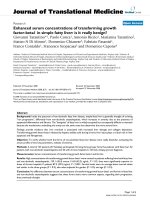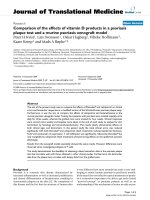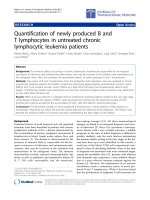báo cáo hóa học: " Simvastatin inhibits interferon-γ-induced MHC class II up-regulation in cultured astrocytes" potx
Bạn đang xem bản rút gọn của tài liệu. Xem và tải ngay bản đầy đủ của tài liệu tại đây (379.08 KB, 4 trang )
BioMed Central
Page 1 of 4
(page number not for citation purposes)
Journal of Neuroinflammation
Open Access
Short report
Simvastatin inhibits interferon-γ-induced MHC class II
up-regulation in cultured astrocytes
Esther Zeinstra
1
, Nadine Wilczak
1
, Daniel Chesik
1
, Lisa Glazenburg
1,2
,
Frans GM Kroese
2
and Jacques De Keyser*
1
Address:
1
Department of Neurology, University Medical Center Groningen, University of Groningen, Groningen, The Netherlands and
2
Cell
Biology (Immunology Section), University Medical Center Groningen, University of Groningen, Groningen, The Netherlands
Email: Esther Zeinstra - ; Nadine Wilczak - ; Daniel Chesik - ;
Lisa Glazenburg - ; Frans GM Kroese - ; Jacques De
Keyser* -
* Corresponding author
Abstract
Based on their potent anti-inflammatory properties and a preliminary clinical trial, statins (HMG-
CoA reductase inhibitors) are being studied as possible candidates for multiple sclerosis (MS)
therapy. The pathogenesis of MS is unclear. One theory suggests that the development of
autoimmune lesions in the central nervous system may be due to a failure of endogenous inhibitory
control of MHC class II expression on astrocytes, allowing these cells to adapt an interferon (IFN)-
γ-induced antigen presenting phenotype. By using immunocytochemistry in cultured astrocytes
derived from newborn Wistar rats we found that simvastatin at nanomolar concentrations
inhibited, in a dose-response fashion, up to 70% of IFN-γ-induced MHC class II expression. This
effect was reversed by the HMG-CoA reductase product mevalonate. Suppression of the antigen
presenting function of astrocytes might contribute to the beneficial effects of statins in MS.
Findings
Currently available disease-modifying agents for the treat-
ment of multiple sclerosis (MS) reduce the frequency and
severity of relapses. They have to be given parenterally, are
only partially effective, and are associated with adverse
effects and high costs. An open-label clinical trial assess-
ing simvastatin in patients with relapsing remitting MS
revealed a significant reduction in gadolinium-enhancing
lesions on magnetic resonance imaging of the brain,
which is indicative of a disease-modifying effect [1]. Stat-
ins (HMG-CoA reductase inhibitors) are an attractive
treatment option for MS because they are administered
orally and have a relatively favorable safety profile. Clini-
cal studies to test the effects of statins in MS are ongoing.
Statins reduce the migration of leukocytes into the central
nervous system (CNS), induce a Th2 phenotype in T-cells,
and decrease the expression of cytokines and inflamma-
tory mediators [2]. A key step in the generation of autoim-
mune lesion formation in MS is the interaction of
activated anti-myelin T cells with their specific antigen
presented by major histocompatibility complex (MHC)
class II molecules, expressed on the membrane of antigen
presenting cells. Statins have been shown to reduce MHC
class II expression in cultured microglia [3]. There is no
consensus about whether microglia or astrocytes repre-
sent the principal CNS antigen presenting cells in MS [4].
A number of observations failed to detect MHC class II
molecules on astrocytes in MS [5-7].
Published: 21 July 2006
Journal of Neuroinflammation 2006, 3:16 doi:10.1186/1742-2094-3-16
Received: 02 May 2006
Accepted: 21 July 2006
This article is available from: />© 2006 Zeinstra et al; licensee BioMed Central Ltd.
This is an Open Access article distributed under the terms of the Creative Commons Attribution License ( />),
which permits unrestricted use, distribution, and reproduction in any medium, provided the original work is properly cited.
Journal of Neuroinflammation 2006, 3:16 />Page 2 of 4
(page number not for citation purposes)
However, other investigators found that, in contrast to
other conditions of CNS inflammation, scattered astro-
cytes at the edges of active MS lesions expressed MHC
class II molecules [8-13], co-stimulatory B7 molecules
[14], and adhesion molecules such as ICAM-1, indicating
that these cells possess the necessary attributes to act as
facultative antigen presenting cells [4]. We previously
reported that astrocytes in the CNS of MS patients are defi-
cient in β
2
-adrenergic receptors. We hypothesized that this
defect allows IFN-γ released from activated T-cells to over-
come the normal endogenous mechanisms that tightly
suppress MHC class II expression on astrocytes [4,15,16].
In this study we assessed the effects of simvastatin on the
interferon (IFN)-γ-induced upregulation of MHC class II
molecules in cultured rat astrocytes.
Astrocytes obtained from neonatal Wistar rats were cul-
tured in Dulbecco's modified Eagle's medium (DMEM)
with 10% heat-inactivated fetal calf serum, 1% L-
glutamine, 1% penicilline-streptamycine and 1% sodium
pyruvate. A 95% pure astrocyte culture could be obtained.
Cells were plated on coverslips coated with poly-L-lysine
(PLL; Sigma, Saint Louis, MO, USA), until a monolayer
was reached. All incubation experiments were performed
3 times in duplicate. To study the kinetics of MHC class II,
IFN-γ concentrations of 6.5 × 10
-8
to 10
-12
were evaluated
at 24, 48 and 72 hours. MHC class II expression in astro-
cytes was maximal following IFN-γ stimulation for 48
hours at a concentration of 6.5 × 10
-11
M (not shown).
Simvastatin at different concentrations from 10
-11
to 10
-8
M was simultaneously added with 6.5 × 10
-11
M IFN-γ for
48 hours. Cells were stained for MHC class II with mouse-
anti-rat OX-17 (Serotec, Oxford, UK), 1:50 followed by
secondary antibody sheep-anti-mouse biotin 1:200, 1
hour at room temperature, and incubation with alkaline
phoshatase-streptavidin 1:300 for 1 hour. Blocking of
non-specific background was done with 3% normal sheep
serum. The coverslips were mounted in Aquamount. The
percentages of positive cells were evaluated through
microscopy and Quantimet image analysis (Leica, Rijsw-
ijk, The Netherlands).
We also performed immunofluorescence staining for
GFAP and MHC class II with primary antibodies mouse-
anti-rat OX-17 (1:25) and rabbit-anti-human GFAP
(Sigma, Saint Louis, USA; 1:400) with 0.5% goat serum
and 0.1% triton X-100, followed by secondary antibodies
goat-anti-mouse FITC 1:200 and goat-anti-rabbit TRITC
1:400. Non-specific background was blocked with 2%
normal goat serum. The cells were air-dried, coverslipped
with anti-fading (DAKO, Carpinteria, CA, USA), kept in
the dark, and analysed using confocal laser scanning
microscopy. Semi-quantitative measurement of pixel den-
sity was performed with Scion image software (Scion Cor-
poration, Frederick, MD, USA).
Results are illustrated in figure 1. In baseline culture con-
ditions 11.0 ± 1.8% (SD) of the astrocytes expressed MHC
class II molecules, with a mean pixel intensity of 55.0 ±
8.0 pixels/inch
2
as measured in the immunofluorescence
staining. After IFN-γ stimulation, 70 ± 3.0% of the astro-
A. Percentage of MHC class II positive astrocytes (mean ± SEM)Figure 1
A. Percentage of MHC class II positive astrocytes (mean ±
SEM). a, non-stimulated conditions; b, after IFN-γ stimulation,
c, IFN-γ + 10
-11
M simvastatin; d, IFN-γ + 10
-10
M simvastatin;
e, IFN-γ + 10
-9
M simvastatin; f, IFN-γ + 10
-8
M simvastatin; g,
IFN-γ + 10
-8
M simvastatin + 100 µM mevalonate. B. Immun-
ofluorescence staining for MHC class II. a, non-stimulated
conditions; b, after IFN-γ stimulation, c, IFN-γ + 10
-8
M simv-
astatin; d, IFN-γ + 10
-8
M simvastatin + 100 µM mevalonate.
Journal of Neuroinflammation 2006, 3:16 />Page 3 of 4
(page number not for citation purposes)
cytes expressed MHC II molecules, with a mean pixel
intensity of 247.5 ± 9.5 pixels/inch
2
. Simvastatin 0.1 nM
inhibited IFN-γ-induced MHC class II up-regulation by
70% (p = 0.004), and mean pixel intensity was reduced to
80.2 ± 12.9 pixels/inch
2
(p = 0.007). Higher concentra-
tions of simvastatin (1 nM and 10 nM) did not produce
greater degree of inhibition; about 20% of astrocytes
remained MHC class II positive. These effects of simvasta-
tin were reversed with the addition of 100 µM mevalonate
(Sigma, St. Louis, MO, USA; 62.5 ± 9.3% positive cells and
236.3 ± 13.1 pixels/inch
2
), indicating that the inhibition
of HMG-CoA reductase mediates the simvastatin-induced
suppression of MHC class II on astrocytes.
IFN-γ-inducible MHC class II gene expression is transcrip-
tionally regulated by class II transcriptional activator
(CIITA). Astrocytic CIITA-deficient mice were resistant to
experimental allergic encephalitis (EAE), an animal
model of the inflammatory component of MS, although T
cells proliferated and secreted Th1 cytokines [17]. These
mice were also resistant to EAE by adoptive transfer of
encephalitogenic class II-restricted CD4(+) Th1 cells, indi-
cating that astrocytic CIITA-dependent MHC class II
expression is required for CNS antigen presentation.
Simvastatin was only able to partially suppress IFN-γ-
induced MHC class II immunostaining in astrocytes. Max-
imum effective inhibition was 70%, which is similar to
that observed with interferon beta [18]. Whether this inhi-
bition is also partial in vivo is uncertain, as MHC class II
expression on astrocytes in situ is under control of endog-
enous inhibitory factors, such as norepinephrine, gluta-
mate and vasointestinal peptide [4]. IFN-γ-induced MHC
class II expression in astrocytes may partially be evoked by
a mechanism that is not suppressible by simvastatin.
Statins have pleiotrophic effects on the immune system.
The exact mechanism of action of statins in reducing dis-
ease activity of MS is uncertain. If the hypothesis that acti-
vation of astrocytes plays a key role in initiating
autoimmune responses in MS is correct, then inhibition
of astrocytic MHC class II expression may represent an
important additional mechanism by which statins reduce
disease activity in MS.
Competing interests
The author(s) declare that they have no competing inter-
ests.
Authors' contributions
EZ and JDK participated in the design of the study and
prepared the manuscript. EZ, NW, DC and LG carried out
the cell cultures, immunocytochemical analysis and quan-
tification of the data. FGMK participated in the design of
the study and helped to draft the manuscript. All authors
read and approved the final manuscript.
Acknowledgements
This work was supported by Multiple Sclerosis Internationaal (The Nether-
lands).
References
1. Vollmer T, Key L, Durkalski V, Tyor W, Corboy J, Markovic-Plese S,
Preiningerova J, Rizzo M, Singh I: Oral simvastatin treatment in
relapsing-remitting multiple sclerosis. Lancet 2004,
363(9421):1607-1608.
2. Neuhaus O, Stuve O, Zamvil SS, Hartung HP: Are statins a treat-
ment option for multiple sclerosis? Lancet Neurol 2004,
3(6):369-371.
3. Youssef S, Stuve O, Patarroyo JC, Ruiz PJ, Radosevich JL, Hur EM,
Bravo M, Mitchell DJ, Sobel RA, Steinman L, Zamvil SS: The HMG-
CoA reductase inhibitor, atorvastatin, promotes a Th2 bias
and reverses paralysis in central nervous system autoim-
mune disease. Nature 2002, 420(6911):78-84.
4. De Keyser J, Zeinstra E, Frohman E: Are astrocytes central play-
ers in the pathophysiology of multiple sclerosis? Arch Neurol
2003, 60(1):132-136.
5. Hayashi T, Morimoto C, Burks JS, Kerr C, Hauser SL: Dual-label
immunocytochemistry of the active multiple sclerosis lesion:
major histocompatibility complex and activation antigens.
Ann Neurol 1988, 24(4):523-531.
6. Bo L, Mork S, Kong PA, Nyland H, Pardo CA, Trapp BD: Detection
of MHC class II-antigens on macrophages and microglia, but
not on astrocytes and endothelia in active multiple sclerosis
lesions. J Neuroimmunol 1994, 51(2):135-146.
7. Boyle EA, McGeer PL: Cellular immune response in multiple
sclerosis plaques. Am J Pathol 1990, 137(3):575-584.
8. Ransohoff RM, Estes ML: Astrocyte expression of major histo-
compatibility complex gene products in multiple sclerosis
brain tissue obtained by stereotactic biopsy. Arch Neurol 1991,
48(12):1244-1246.
9. Lee SC, Moore GR, Golenwsky G, Raine CS: Multiple sclerosis: a
role for astroglia in active demyelination suggested by class
II MHC expression and ultrastructural study. J Neuropathol Exp
Neurol 1990, 49(2):122-136.
10. Lee SC, Raine CS: Multiple sclerosis: oligodendrocytes in active
lesions do not express class II major histocompatibility com-
plex molecules. J Neuroimmunol 1989, 25(2-3):261-266.
11. Traugott U, Lebon P: Interferon-gamma and Ia antigen are
present on astrocytes in active chronic multiple sclerosis
lesions. J Neurol Sci 1988, 84(2-3):257-264.
12. Traugott U, Scheinberg LC, Raine CS: On the presence of Ia-pos-
itive endothelial cells and astrocytes in multiple sclerosis
lesions and its relevance to antigen presentation. J Neuroim-
munol 1985, 8(1):1-14.
13. Zeinstra E, Wilczak N, Streefland C, De Keyser J: Astrocytes in
chronic active multiple sclerosis plaques express MHC class
II molecules. Neuroreport 2000, 11(1):89-91.
14. Zeinstra E, Wilczak N, De Keyser J: Reactive astrocytes in
chronic active lesions of multiple sclerosis express co-stimu-
latory molecules B7-1 and B7-2. J Neuroimmunol 2003, 135(1-
2):166-171.
15. De Keyser J, Wilczak N, Leta R, Streetland C: Astrocytes in multi-
ple sclerosis lack beta-2 adrenergic receptors. Neurology 1999,
53(8):1628-1633.
16. De Keyser J, Zeinstra E, Wilczak N: Astrocytic beta2-adrenergic
receptors and multiple sclerosis. Neurobiol Dis 2004,
15(2):331-339.
17. Stuve O, Youssef S, Slavin AJ, King CL, Patarroyo JC, Hirschberg DL,
Brickey WJ, Soos JM, Piskurich JF, Chapman HA, Zamvil SS: The role
of the MHC class II transactivator in class II expression and
antigen presentation by astrocytes and in susceptibility to
central nervous system autoimmune disease. J Immunol 2002,
169(12):6720-6732.
18. Satoh J, Paty DW, Kim SU: Differential effects of beta and
gamma interferons on expression of major histocompatibil-
ity complex antigens and intercellular adhesion molecule-1
Publish with Bio Med Central and every
scientist can read your work free of charge
"BioMed Central will be the most significant development for
disseminating the results of biomedical research in our lifetime."
Sir Paul Nurse, Cancer Research UK
Your research papers will be:
available free of charge to the entire biomedical community
peer reviewed and published immediately upon acceptance
cited in PubMed and archived on PubMed Central
yours — you keep the copyright
Submit your manuscript here:
/>BioMedcentral
Journal of Neuroinflammation 2006, 3:16 />Page 4 of 4
(page number not for citation purposes)
in cultured fetal human astrocytes. Neurology 1995,
45(2):367-373.









